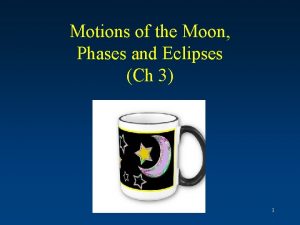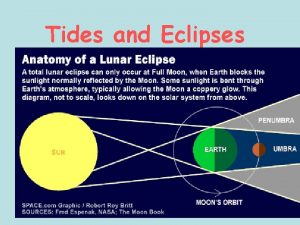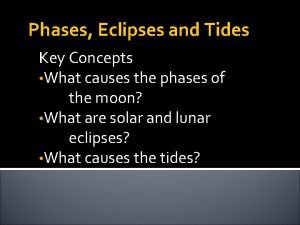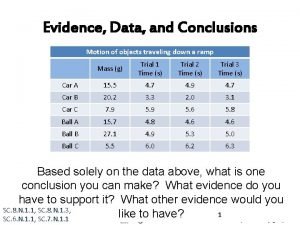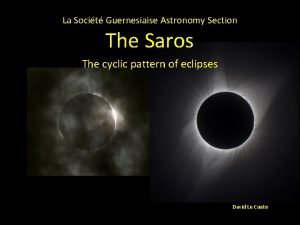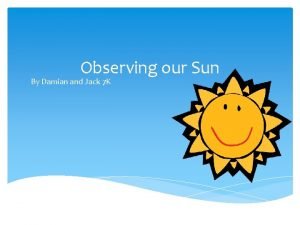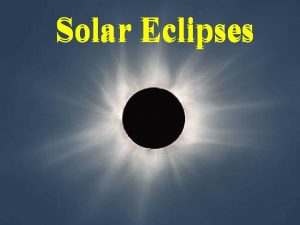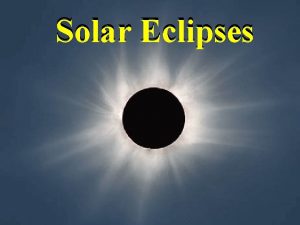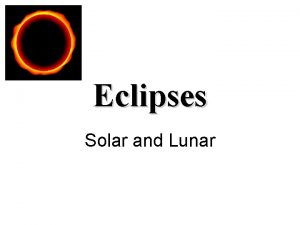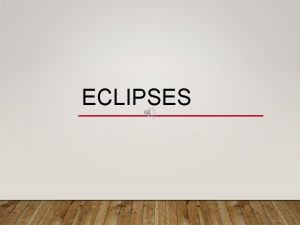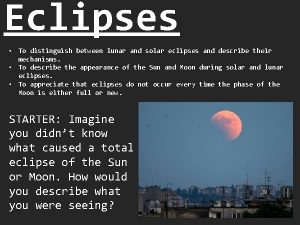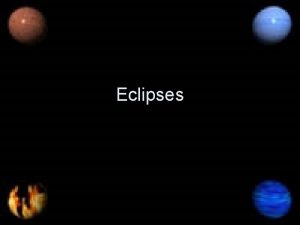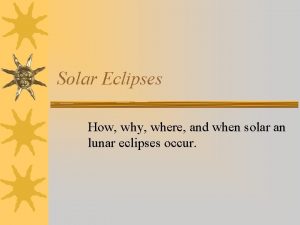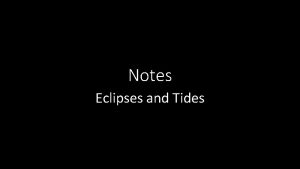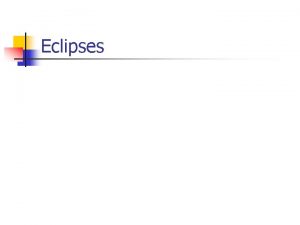Eclipses Solar Eclipses n n n Eclipses of












- Slides: 12

Eclipses

Solar Eclipses n n n Eclipses of the sun Can only occur at New Moon when the Moon passes between Earth and Sun. Since New Moon occurs every 29 1/2 days, you might think that we should have a solar eclipse about once a month. Unfortunately, this doesn't happen because the Moon's orbit around Earth is tilted 5 degrees to Earth's orbit around the Sun. As a result, the Moon's shadow usually misses Earth as it passes above or below our planet at New Moon. At least twice a year, the geometry lines up just right so that some part of the Moon's shadow falls on Earth's surface and an eclipse of the Sun is seen from that region.

The Moon’s Shadow n Actually has 2 parts: Penumbra - Faint outer shadow; partial eclipses are seen from within this shadow. n Umbra- Dark inner shadow; total eclipses are seen from within this shadow. n

Partial Solar Eclipse When only the Moon's penumbral shadow strikes Earth, we see a partial eclipse of the Sun from that region. n Partial eclipses are dangerous to look at because the un-eclipsed part of the Sun is still very bright. n n You must use special filters or a home-made pinhole projector to safely watch a partial eclipse of the Sun

Partial Solar Eclipses

Total Solar Eclipse n n However, if the Moon's dark umbral shadow sweeps across Earth's surface, then a total eclipse of the Sun is seen. The track of the Moon's shadow across Earth's surface is called the Path of Totality. n n n It is typically 10, 000 miles long but only 100 miles or so wide. In order to see the Sun totally eclipsed by the Moon, you must be in the path of totality. The total phase of a solar eclipse is very brief. It rarely lasts more than several minutes

Total Solar Eclipse Austria

Lunar Eclipses n Lunar Eclipse n An eclipse of the moon n Can only occur at a full moon and only if the moon passes through part of the Earth’s shadow n Safe to watch with unprotected eyes. n There are three basic types of lunar eclipses n Penumbral Lunar Eclipse n Partial Lunar Eclipse n Total Lunar Eclipse

Penumbral Lunar Eclipse Where the moon passes through Earth’s penumbral shadow n These events are subtle and difficult to observe. n

Partial Lunar Eclipse A portion of the moon passes through Earth’s umbral shadow n These events are easy to see. n

Total Lunar Eclipse The entire moon passes through Earth’s umbral shadow n During this time, the Earth is blocking the sun’s light from reaching the surface of the moon. n As astronaut sitting on the moon would see a red ring around Earth, where Earth was blocking the sun n These events are quite striking n

 Wholesale panel solar cell
Wholesale panel solar cell Solar energy is free. solar is inexhaustible
Solar energy is free. solar is inexhaustible Lunar eclipse moon phase
Lunar eclipse moon phase Tides and eclipses
Tides and eclipses Lesson outline lesson 3 eclipses and tides answer key
Lesson outline lesson 3 eclipses and tides answer key Facts about first quarter moon
Facts about first quarter moon Sonido
Sonido The two eclipses
The two eclipses What causes eclipses
What causes eclipses Eclipses and tides lesson 3
Eclipses and tides lesson 3 Eclipses
Eclipses The two eclipses
The two eclipses Types of eclipses
Types of eclipses


